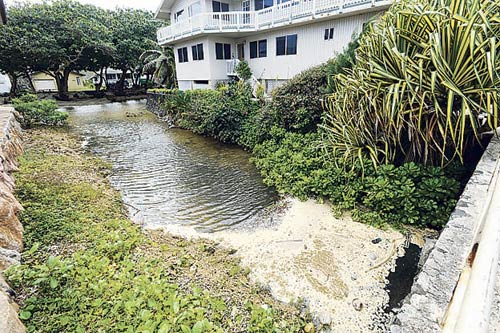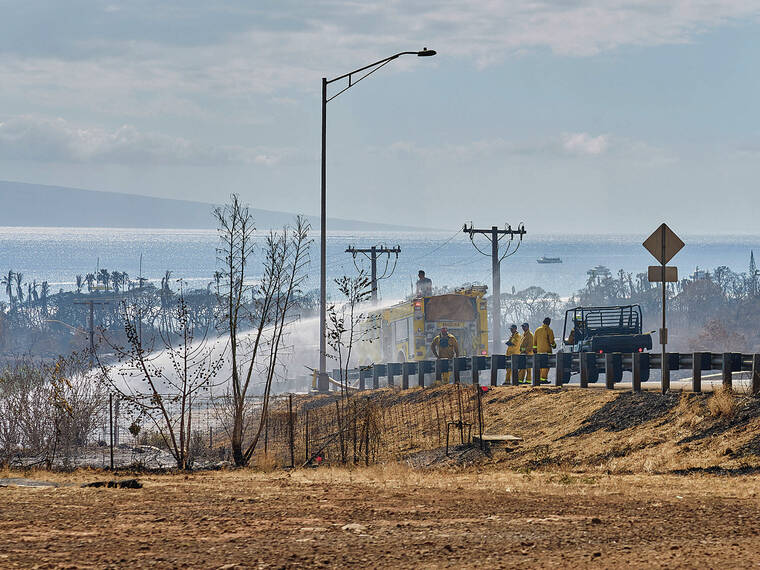Flooding hassles in Hauula have hui ‘looking at litigation’

Amy Madsen stood Sunday on a footbridge next to a bridge over Kaluanui Stream in Hauula, where flooding occurs during heavy rain when sand blocks the stream from emptying into the ocean.

Hauula residents living near Kaluanui Stream say they have noticed an increase in the formation of algae building up on the water’s surface.


Some coastal residents of Hauula are increasingly fed up with chronic flooding trouble they say has been made worse by a drainage pipe valve installed by the city.
"At this point, if we don’t get a resolution, we’re looking at litigation," said Amy Madsen, president of the Hauula Beach Homes Association of Apartment Owners.
Madsen said nearby Kaluanui Stream routinely floods into yards and homes along Pokiwai Place and surrounding streets during heavy rain because sand builds up and blocks the flow to the ocean. Residents themselves have had to dig an opening under the Kamehameha Highway bridge over the stream to let water out, or the Honolulu Fire Department comes and blasts the sand out with a hose, she said.
On Nov. 28 the city installed a "duckbill valve" onto the mouth of a pipe that runs under the bridge as a way to keep sand from backing up into the pipe.
But Madsen said the valve is causing more problems.
The duckbill valve is designed to open when water is flowing through the pipe but remain closed when it isn’t, in order to keep sand from entering and backing up the pipe.
Don't miss out on what's happening!
Stay in touch with breaking news, as it happens, conveniently in your email inbox. It's FREE!
Madsen said it’s difficult for water to exit the valve because it is often blocked by sand, and that its thick rubberlike material is too strong for a trickle of water to pass through. And with ocean water no longer entering the pipe and mixing with the stream, she said, the stream is turning putrid and killing fish.
There has also been an increased presence of a filmy white and brown substance.
"Honestly, it’s kind of always been this way, but it’s gotten worse with the duckbill," said Madsen, suggesting that the substance could possibly be fecal matter because the community runs on cesspools and is not connected to the city’s sewer system.
Verna Ulii, 45, said she has lived in the community her whole life, and as a kid used to swim in the stream, which was clean.
"We used to have a lot of fish here," she said. "We used to go fishing every day."
Madsen said she is also bothered that the city did not consult community members before installing the valve.
Until now, Madsen said, the state has been relatively helpful when it comes to flooding.
"They’ve actually dug us out a few times," she said. "But now (that) the duckbill is in, the state is using it as an excuse not to help us (because the city installed it)."
A few years ago, Madsen said, she and a some other residents explored the area upstream to find out where the water was coming from and discovered a "sharp 90-degree turn" directing the stream toward Kailua, followed by another 90 degree turn guiding it toward the ocean. She said it appears the stream was rerouted many decades ago to accommodate the Sacred Falls State Park parking lot. The park has been closed to visitors since 1999, when a rockfall killed eight hikers and wounded several others.
When Madsen presented the state recently with a study conducted by the Army Corps of Engineers about five years ago that concluded the configuration of the stream is unnatural, she said state Sen. Clayton Hee responded by setting aside $1 million for an upcoming project that will install earthen berms around the first bend to help prevent flooding in her community.
"This whole infrastructure needs to be looked at," she said. "I guarantee if that stream went from mountain to ocean, we wouldn’t see the amount of flooding we’ve seen."
The state Department of Land and Natural Resources installed concrete barriers around the first bend in December 2007 at a cost of $32,000 in an attempt to prevent water from spilling over and running off into the Pokiwai Place community.
Madsen said the barriers were of little help and are now overgrown. She plans to meet with DLNR during a hearing at the state Capitol this week to be briefed about the current plan to install the earthen berms.




